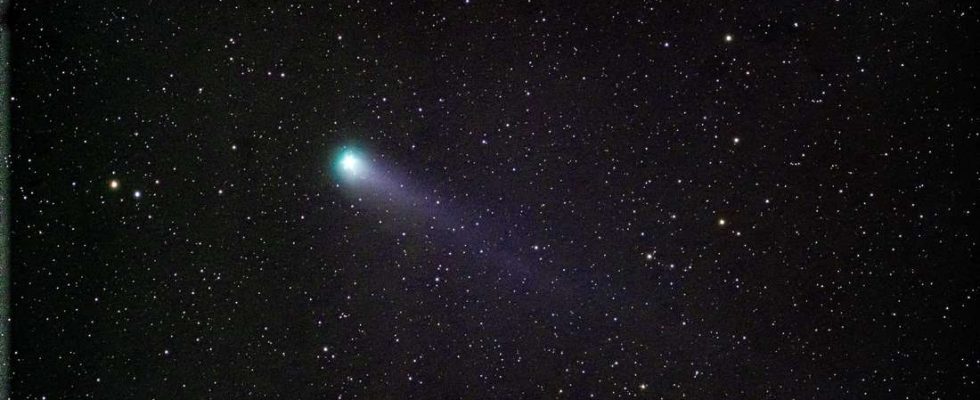Press
Comet 12P/Pons-Brooks attracted attention with “devil horns” – and can now be seen in the evening sky. An expert gives observation tips.
Update from March 28th, 10:50 a.m.: Comet 12P/Pons-Brooks is currently best seen in the sky. The comet, whose nucleus has a diameter of around 30 kilometers, can be admired in the sky until around April 10th. But even though the comet is significantly larger than Mount Everest, it can only be seen small in the evening sky – after all, it is very far from Earth and only comes within around 225 million kilometers.
“Devil Comet” 12P/Pons-Brooks is now visible in the sky
First report from March 22, 2024: Munich – Since the comet “Neowise”, which was visible in the sky with the naked eye in the summer of 2020, there has not been one that is clearly visible Comets more in the night sky – until now. For some time now it has been possible to observe Comet 12P/Pons-Brooks using small binoculars or, in good conditions, even without any aids. A few months ago the celestial body took care of things Outbreaks and the resulting “devil horns” caused a stir – now the “devil’s comet” is on its way towards the sun and earth.
12P/Pons-Brooks is a periodic comet that takes 71 years to arrive Sun to circle once. On its long journey around our central star Solar system The comet is currently approaching the sun. On April 21, 2024, it will reach the point in its orbit closest to the Sun, the so-called perihelion. Then 12P/Pons-Brooks is still about 0.781 astronomical units (equivalent to about 117 million kilometers) from the sun and is racing through space at a speed of almost 170,000 kilometers per hour.
Comet 12P/Pons-Brooks approaches the Sun and Earth
After perihelion, Comet 12P/Pons-Brooks moves away from the Sun and approaches Earth. On June 2, 2024, it will come within 1.5 astronomical units (about 225 million kilometers) of Earth. However, if you want to observe the comet, you should lie in wait before these two dates. Comet expert Uwe Pilz from the Association of Star Friends (VdS) explains Merkur.de from IPPEN.MEDIAwhy: “The clearest visibility should be at the end of March, you have a chance until around April 10th.” But the comet is then closer to the horizon and has to be observed at dusk.
To find 12P/Pons-Brooks in the sky, look west at or after dusk and look for a milky speck or “fuzzy star.” The comet is located between the constellations Andromeda, Pisces, Triangle and Aries. There are also currently in the region Planets Mercury (very low above the horizon) and Jupiter (slightly higher than the comet) can be seen. A problem for beginners: Until March 28th, the comet will be in an area where there are no clearly visible stars for orientation.
| 12P/Pons Brooks |
| periodic comet (Halley type) |
| July 12, 1812 |
| Jean-Louis Pons (1812) and William Robert Brooks (rediscovered in 1883) |
| 71 years |
| approx. 30 kilometers |
Star Alpha Arietis helps search for Comet 12P/Pons-Brooks
Then that changes: “From March 29th to April 2nd it is very close to the bright Alpha Arietis,” explains Pilz. The star, also called Hamal, will be visible around 8 p.m. when the sky is still quite bright. “But since the comet is now much brighter, it stands out in binoculars. The tail should be easily recognizable,” says the comet expert. Pilz estimates that 12P/Pons-Brooks may even be visible to the naked eye.
In the coming days until April 10th, the comet will continue to move towards Jupiter. It becomes brighter, but also gets closer to the sun. This means: It can only be seen at dusk; when it gets really dark, the comet has long since set. Whoever goes to total solar eclipse on April 8th in the USA may be able to observe comet 12P/Pons-Brooks during totality in the daytime sky.
Picturesque meeting in the sky: crescent moon and Jupiter meet comet
On April 10th, with a bit of luck, you can see a particularly picturesque meeting in the sky: the narrow crescent moon visits the giant planet Jupiter, and a little below you can see the comet 12P/Pons-Brooks – probably for the last time before it no longer appears in the northern sky you can see. (tab)

